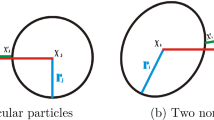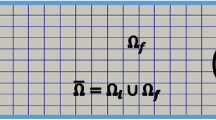Abstract
We have examined the behavior of a suspended solid particle floating in a fluid and interacting with circular cylinders inside a channel. The interaction of particles with cylinders, outer boundary and with the fluid is analyzed. Solid particles move freely in the fluid along a fixed computational mesh using an Eulerian approach. Treatment of fluid and particle interaction is achieved using the fictitious boundary method (FBM). A modification in the collision model, proposed by Singh, Glowinski, Joseph, and coauthors, is presented to handle particle-cylinder interactions. The particulate flow is computed using multigrid finite element solver FEATFLOW (Finite element analysis tool for flow problems). Numerical experiments are performed considering different particle positions and different alignments of cylinders and their effect on particle trajectories has been studied. Effects of the particle-wall, particle-cylinder and particle-fluid interaction on the motion of the particles and on the physical behavior of the fluid-particle system have been analyzed. Results for the sharp increase in the amplitude of drag forces on the cylinders, arising due to a nearby passing particle have been presented.





Similar content being viewed by others
References
Usman K, Walayat K, Wang Z, Liu M (2017) A multigrid finite element fictitious boundary method for fluid-solid two-phase flows. In Advances in Computational Engineering Science, editor, The 8th International Conference on Computational Mehtods (ICCM2017). ScienTech Publisher
Koblitz AR, Lovett S, Nikiforakis N, Henshaw WD (2017) Direct numerical simulation of particulate flows with an overset grid method. J Comput Phys 343:414–431
Yang J, Stern F (2015) A non-iterative direct forcing immersed boundary method for strongly coupled fluid? solid interactions. J Comput Phys 295:779–804
Costarelli SD, Garelli L, Cruchaga MA, Storti MA, Ausensi R, Idelsohn SR (2016) An embedded strategy for the analysis of fluid structure interaction problems. Comput Meth Appl Mech Eng 300:106–128
Usman K, Ali J, Mahmood R, Bilal S, Jabeen S, Asmat J (2020) Study of a falling rigid particle passing around obstacles in a fluid channel. Int J Comput Fluid Dyn 34(9):644–655
Ogawa S (1978) Multitemperature theory of granular materials. In Proc. of the US-Japan Seminar on Continuum Mechanical and Statistical Approaches in the Mechanics of Granular Materials, 1978, pages 208–217. Gakajutsu Bunken Fukyu-Kai
Kesava Rao K, Nott Prabhu R (2008) An introduction to granular flow. Cambridge University Press, Cambridge
Sokolov A, Ali R, Turek S (2015) An afc-stabilized implicit finite element method for partial differential equations on evolving-in-time surfaces. Journal of Computational and Applied Mathematics, 289:101 – 115. Sixth International Conference on Advanced Computational Methods in Engineering (ACOMEN 2014)
Shen H (1994) Granular matter: an interdisciplinary approach. edited by a. mehta, springer-verlag, new york, 306 pp., 1994. AIChE Journal, 40(11):1925–1925
Campbell CS (1990) Rapid granular flows. Ann Rev Fluid Mech 22(1):57–90
Cleary PW (1998) Discrete element modelling of industrial granular flow applications. TASK. Quart Sci Bull 2:385–416
Cleary PW (2000) Dem simulation of industrial particle flows: case studies of dragline excavators, mixing in tumblers and centrifugal mills. Pow Technol 109(1):83–104
Glowinski R, Pan TW, Hesla TI, Joseph DD (1999) A distributed lagrange multiplier/fictitious domain method for particulate flows. Int J Multiph Flow 25(5):755–794
Hirt CW, Amsden AA, Cook JL (1974) An arbitrary lagrangian-eulerian computing method for all flow speeds. J Comput Phys 14(3):227–253
Maury B (1996) Characteristics ale method for the unsteady 3d navier-stokes equations with a free surface. Int J Comput Fluid Dyn 6(3):175–188
Wan D, Turek S (2007) Fictitious boundary and moving mesh methods for the numerical simulation of rigid particulate flows. J Comput Phys 222(1):28–56
Singh P, Hesla TI, Joseph DD (2003) Distributed lagrange multiplier method for particulate flows with collisions. Int J Multiph Flow 29(3):495–509
Patankar NA, Singh P, Joseph DD, Glowinski R, Pan TW (2000) A new formulation of the distributed lagrange multiplier/fictitious domain method for particulate flows. Int J Multiphase Flow 26:1509–1524
Walayat K, Wang Z, Usman K, Liu M (2018) An efficient multi-grid finite element fictitious boundary method for particulate flows with thermal convection. Int J Heat Mass Trans 126:452–465
Usman K, Walayat K, Mahmood R, Kousar N (2018) Analysis of solid particles falling down and interacting in a channel with sedimentation using fictitious boundary method. AIP Adv 8(6):065201
Walayat K, Zhang Z, Usman K, Chang J, Liu M (2018) Dynamics of elliptic particle sedimentation with thermal convection. Phys Fluids 30(10):103301
Walayat K, Zhang Z, Usman K, Chang J, Liu M (2019) Fully resolved simulations of thermal convective suspensions of elliptic particles using a multigrid fictitious boundary method. Int J Heat Mass Transf 139:802–821
Jabeen S, Usman K, Walayat K (2020) Numerical investigations for a chain of particles settling in a channel. Comput Part Mech 7(4):615–627
Tsai L-H, Chang C-C, Pan T-W, Glowinski R (2018) Numerical study of the wall effect on particle sedimentation. Int J Comput Fluid Dyn 32(2–3):158–166
Glowinski R, Pan T-W, Periaux J (1998) Distributed lagrange multiplier methods for incompressible viscous flow around moving rigid bodies. Comput Meth Appl Mech Eng 151(1–2):181–194
Glowinski R (2003) Finite element methods for incompressible viscous flow. Handb Num Anal 9:3–1176
Patankar Neelesh A, Pushpendra Singh, Joseph Daniel D, Roland Glowinski, Pan T-W (2000) A new formulation of the distributed lagrange multiplier/fictitious domain method for particulate flows. Int J Multiph Flow 26(9):1509–1524
Sangani AS, Mo G (1994) Inclusion of lubrication forces in dynamic simulations. Phys Fluids 6(5):1653–1662
Abbasi WS, Islam S, Rahman H, Manzoor R (2018) Numerical investigation of fluid-solid interaction for flow around three square cylinders. AIP Adv 8(2):025221
Inoue O, Mori M, Hatakeyama N (2006) Aeolian tones radiated from flow past two square cylinders in tandem. Phys Fluids 18(4):046101
Lu D, Ramzan M, Ahmad S, Chung JD, Farooq U (2017) Upshot of binary chemical reaction and activation energy on carbon nanotubes with cattaneo-christov heat flux and buoyancy effects. Phys Fluids 29(12):123103
Wang S, Tian F, Jia L, Xi-yun L, Yin X (2010) Secondary vortex street in the wake of two tandem circular cylinders at low reynolds number. Phys Rev E 81(3):036305
Ladd AJC (1994) Numerical simulations of particulate suspensions via a discretized boltzmann equation. part 1. theoretical foundation. J Fluid Mech 271:285–309
Brady JF, Bossis G (1988) Stokesian dynamics. Ann Rev Fluid Mech 20(1):111–157
Wan D, Turek S (2007) An efficient multigrid-fem method for the simulation of solid-liquid two phase flows. J Comput Appl Math 203(2):561–580
Kushch VI, Sangani AS, Spelt PDM, Koch DL (2002) Finite-weber-number motion of bubbles through a nearly inviscid liquid. J Fluid Mech 460:241–280
Tsao H-K, Koch DL (1994) Collisions of slightly deformable, high reynolds number bubbles with short range repulsive forces. Phys Fluids 6(8):2591–2605
Davis RH (1992) Effects of surface roughness on a sphere sedimenting through a dilute suspension of neutrally buoyant spheres. Phys Fluids A Fluid Dyn 4(12):2607–2619
Zeng S, Kerns ET, Davis RH (1996) The nature of particle contacts in sedimentation. Phys Fluids 8(6):1389–1396
Zhang J, Fan L-S, Zhu C, Pfeffer R, Qi D (1999) Dynamic behavior of collision of elastic spheres in viscous fluids. Powder Technol 106(1–2):98–109
Jian-Zhong L, Ye-Long W, Olsen JA (2005) Sedimentation of rigid cylindrical particles with mechanical contacts. Chin Phys Lett 22(3):628
Usman Kamran (2013) Numerical analysis of collision models in 2D particulate flow. PhD thesis, Technische Universitaet Dortmund, Fakultaet fuer Mathematik
Arp PA, Mason SG (1977) The kinetics of flowing dispersions: Ix. doublets of rigid spheres (experimental). J Coll Int Sci 61(1):44–61
Ardekani AM, Rangel RH (2006) Unsteady motion of two solid spheres in Stokes flow. Phys Fluids 18(10):103306
Ardekani AM, Rangel RH (2008) Numerical investigation of particle-particle and particle-wall collisions in a viscous fluid. J Fluid Mech 596:437–466
Patankar S (2018) Numerical heat transfer and fluid flow. CRC Press, USA
Turek Stefan, Wan Decheng, Rivkind Liudmila S (2003) The fictitious boundary method for the implicit treatment of dirichlet boundary conditions with applications to incompressible flow simulations. In Challenges in Scientific Computing-CISC 2002, pages 37–68. Springer
John V (2002) Higher order finite element methods and multigrid solvers in a benchmark problem for the 3d Navier-Stokes equations. Int J Num Meth Fluids 40:775–798
Turek Stefan (2005) Numerical Analysis of a New Time-stepping \(\theta \)-scheme for Incompressible Flow Simulations. Ergebnisberichte angewandte Mathematik. Univ. Dortmund, Fachbereich Mathematik
Wendt JF (ed) (2009) Computational fluid dynamics. Springer, Berlin
Wan D, Turek S (2006) Direct numerical simulation of particulate flow via multigrid fem techniques and the fictitious boundary method. Int J Num Meth Fluids 51(5):531–566
Wan Decheng, Turek Stefan, Rivkind Liudmila S. (2004) An efficient multigrid fem solution technique for incompressible flow with moving rigid bodies. In Miloslav Feistauer, Vit Dolejsi, Petr Knobloch, and Karel Najzar, editors, Numerical Mathematics and Advanced Applications, pages 844–853. Springer Berlin Heidelberg
Kim S, Karrila SJ (2005) Microhydrodynamics: Principles and Selected Applications. Butterworth - Heinemann series in chemical engineering. Dover Publications
Turek S (1996) A comparative study of time-stepping techniques for the incompressible Navier-Stokes equations: From fully implicit non-linear schemes to semi-implicit projection methods. Int J Num Meth Fluids 22(10):987–1011
Turek S (1997) On discrete projection methods for the incompressible Navier-Stokes equations: an algorithmical approach. Comput Meth Appl Mech Eng 143(3):271–288
Turek S (1998) Featflow. finite element software for the incompressible Navier-Stokes equations: User manual, release 1.1. Technical report, Heidelberg University
Author information
Authors and Affiliations
Corresponding author
Additional information
Technical Editor: Daniel Onofre de Almeida Cruz.
Publisher's Note
Springer Nature remains neutral with regard to jurisdictional claims in published maps and institutional affiliations.
Rights and permissions
About this article
Cite this article
Usman, K., Asmat, J., Abbasi, W.S. et al. Analysis of a floating particle interacting with fixed cylinders inside a channel. J Braz. Soc. Mech. Sci. Eng. 43, 565 (2021). https://doi.org/10.1007/s40430-021-03283-z
Received:
Accepted:
Published:
DOI: https://doi.org/10.1007/s40430-021-03283-z




